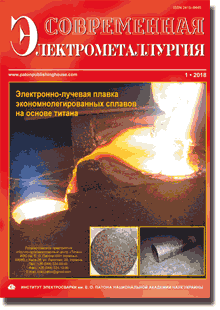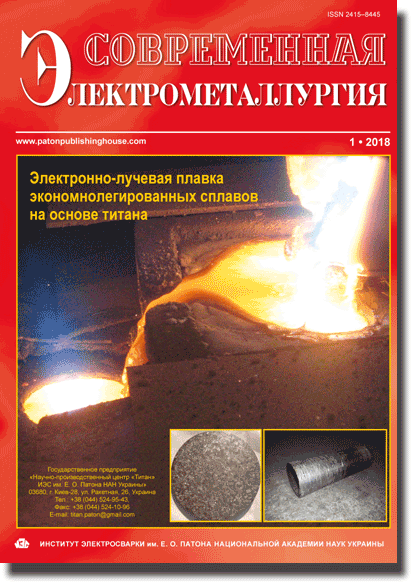
Сучасна електрометалургія, 2018, #1, 3-8 pages
Інститут електрозварювання ім. Є. О. Патона НАН України. 03150, м. Київ, вул. Казимира Малевича, 11. E-mail: office@paton.kiev.ua
Abstract
Зроблено огляд тенденцій розвитку залізничного транспорту і пов’язаних з ними змін умов експлуатації та виникнення дефектів, що скорочують строк служби рейок. Зростання швидкості руху пасажирських потягів і збільшення навантаження на вісь при перевезенні вантажу вимагає покращення якості рейок і властивостей сталей, з яких їх виробляють. Збільшення інтенсивності знакоперемінних контактних навантажень, нагрів при тривалому гальмуванні та корозійні фактори викликають пошкодження рейок. Більшість дефектів рейок, що призводять до виходу їх з ладу, мають контактно-втомне походження і їх утворення часто пов’язано з металургійною якістю сталі, покращення якої потребує технологічних вдосконалень вздовж всього циклу виробництва рейок. Бібліогр. 25, іл. 1.
Ключові слова: залізничні рейки; швидкість руху; навантаження на вісь; умови експлуатації; дефекти втомного походження
Received: 14.02.18
Published: 20.03.18
Список литературы
AS = «Автоматичне зварювання» - 6 накладів на рік;
TPWJ = «PATON WELDING JOURNAL» - 12 накладів на рік;
SEM = «Сучасна електрометалургія» - 4 наклада на рік;
TDNK = «Технічна діагностика та неруйнівний контроль» - 4 наклада на рік.
| 2018 №01 (06) |
DOI of Article 10.15407/sem2018.01.01 |
2018 №01 (02) |

Сучасна електрометалургія, 2018, #1, 3-8 pages
Сучасні рейкові сталі і можливості ЕШП (Огляд). Повідомлення 1. Умови експлуатації рейок та їх дефекти
Л. Б. Медовар, Г. П. Стовпченко, Г. О. Полішко, Є. О. Педченко, В. А. Зайцев
Інститут електрозварювання ім. Є. О. Патона НАН України. 03150, м. Київ, вул. Казимира Малевича, 11. E-mail: office@paton.kiev.ua
Abstract
Зроблено огляд тенденцій розвитку залізничного транспорту і пов’язаних з ними змін умов експлуатації та виникнення дефектів, що скорочують строк служби рейок. Зростання швидкості руху пасажирських потягів і збільшення навантаження на вісь при перевезенні вантажу вимагає покращення якості рейок і властивостей сталей, з яких їх виробляють. Збільшення інтенсивності знакоперемінних контактних навантажень, нагрів при тривалому гальмуванні та корозійні фактори викликають пошкодження рейок. Більшість дефектів рейок, що призводять до виходу їх з ладу, мають контактно-втомне походження і їх утворення часто пов’язано з металургійною якістю сталі, покращення якої потребує технологічних вдосконалень вздовж всього циклу виробництва рейок. Бібліогр. 25, іл. 1.
Ключові слова: залізничні рейки; швидкість руху; навантаження на вісь; умови експлуатації; дефекти втомного походження
Received: 14.02.18
Published: 20.03.18
Список литературы
- (2017) The ten fastest trains in the world… 1801 to present. Smart train world. www.smartrailworld.com/the-fastest-train-in-the-world
- Soejima, H. (2003) Feature: Railway technical research in Asia railway technology in Japan – Challenges and Strategies. Japan Railway & Transport Review, 36, 4–13.
- https://en.wikipedia.org/wiki/TGV
- http://www.rzd.ru/static/public/ru?STRUCTURE_ID=666&layer_id=3290&id=35855-16
- (2017) Xinhua. http://news.xinhuanet.com/english/2017-09/21/c_136626345_2.html
- (2015) Japan train beated a proper record of speed. BBC Ukraine. http://www.bbc.com/ukrainian/science/2015/04/150421_maglev_speed_record_ko
- (2017) Hyperloop work begins before a business case is made. https://amp-ft-com.cdn.ampproject.org/c/s/amp.ft.com/content/64c31810-d375-11e7-ae3e-563c04c5339a
- Saeki, K., Iwano, K. (2013) Progress and prospects of rail for railroads. Nippon Steel & Sumitomo Metal. Technical Report, 105, 21–25.
- Tzanakakis, K. (2013) The railway track and its long term behaviour: A Handbook for a railway track of high quality. Springer Sci. & Business Media.
- Cannon, D.F., Edel, K.O., Grassie, S.L., Sawley, K. (2003) Rail defects: An overview. Fatigue & Fracture of Engineering Materials & Structures, 26(10), 865–886.
- Kumar, S.A. (2006) A study of the rail degradation process to predict rail breaks. Lulea University of Technology, Division of Operation and Maintenance Engineering.
- Nikas, D., Ahlstrom, J., Malakizadi, A. (2016) Mechanical properties and fatigue behaviour of railway wheel steels as influenced by mechanical and thermal loadings. Wear, 366–367, 407–415.
- (2005) Steels: Processing, structure, and performance. Сhapter 15. High-carbon steels: Fully pearlitic microstructures and applications. ASM International. https://www.asminternational.org/documents/10192/1849770/Chapter_15_WEB.pdf
- (2015) Technology for the future. UIC, The Worldwide Railway Organisation. https://uic.org/IMG/pdf/high_speed_brochure.pdf
- Girsch, G., Keichel, J., Gehrmann, R. et al. (2009) Advanced rail steels for heavy haul application-track performance and weldability. 9th International Heavy Haul Conference, 22–25 June 2009, Changhai, China, pp. 171–178.
- One step ahead. https://www.voestalpine.com/schienen/static/sites/schienen/.downloads/Image-Brochure.pdf
- Jiang, X., Li, X., Li, X. Cao, Sh. (2017) Rail fatigue crack propagation in high-speed wheel/rail rolling contact. of Modern Transportation, 25(3), 178–184.
- Olofsson, U., Lewis R. (2009) Tribology of the wheel-rail contact. Ed. by S. Iwnicki. A Handbook of Railway Vehicle Dynamics, Swets & Zeitlinger Publishers.
- Madler, K., Zoll, A., Heyder, R., Brehmer, M. (2008) Rail materials — alternatives and limits. http://www.researchgate.net/publication/267989542_Rail_Materials_Alternatives_and_Limits
- Marais, J.J., Mistry, K.C. (2003) Rail integrity management by means of ultrasonic testing. Fatigue & Fracture of Engineering Materials & Structures, 26(10), 931–938.
- Smith, R. (2002) Rolling contact fatigue of rails: what remains to be done? http://www.railway-research.org/IMG/pdf/512/pdf
- Agarkov, O.V. (2013) Analysis of problems of defects formation in railway track rails. Visnyk Nats. Transport. Un-tu, 28, 3–8 [in Russian].
- Sawley, K., Reiff, R. (2000) Rail failure assessment for the office of the rail regulator. An assessment of Railtrack’s methods for managing broken and defective rails.
- Matvetsov, V., Miroshnikov, N., Kratenok, V. (2013) Damage of rails by defects in different service conditions. Visnyk TNTU, 71(3), 182–189 [in Russian].
- Rudyuk, A.S., Azarkevich, A.A., Voskovets, Yu.A. et al. (2011) Defectiveness of rails on railways of Ukraine. Put i Putevoe Khozyajstvo, 7, 28–32 [in Russian].
Вартість передплати/замовлення на журнали або окремі статті
| журнал/валюта | річний комплект друкований |
1 прим. друкований |
1 прим. електронний |
одна стаття |
| AS/UAH | 1800 грн. | 300 грн. | 300 грн. | 150 грн. |
| AS/USD | 192 $ | 32 $ | 26 $ | 16 $ |
| AS/EUR | 180 € | 30 € | 25 € | 15 € |
| TPWJ/UAH | 7200 грн. | 600 грн. | 600 грн. | 280 грн. |
| TPWJ/USD | 384 $ | 32 $ | 26 $ | 16 $ |
| TPWJ/EUR | 360 € | 30 € | 25 € | 15 € |
| SEM/UAH | 1200 грн. | 300 грн. | 300 грн. | 150 грн. |
| SEM/USD | 128 $ | 32 $ | 26 $ | 16 $ |
| SEM/EUR | 120 € | 30 € | 25 € | 15 € |
| TDNK/UAH | 1200 грн. | 300 грн. | 300 грн. | 150 грн. |
| TDNK/USD | 128 $ | 32 $ | 26 $ | 16 $ |
| TDNK/EUR | 120 € | 30 € | 25 € | 15 € |
AS = «Автоматичне зварювання» - 6 накладів на рік;
TPWJ = «PATON WELDING JOURNAL» - 12 накладів на рік;
SEM = «Сучасна електрометалургія» - 4 наклада на рік;
TDNK = «Технічна діагностика та неруйнівний контроль» - 4 наклада на рік.





